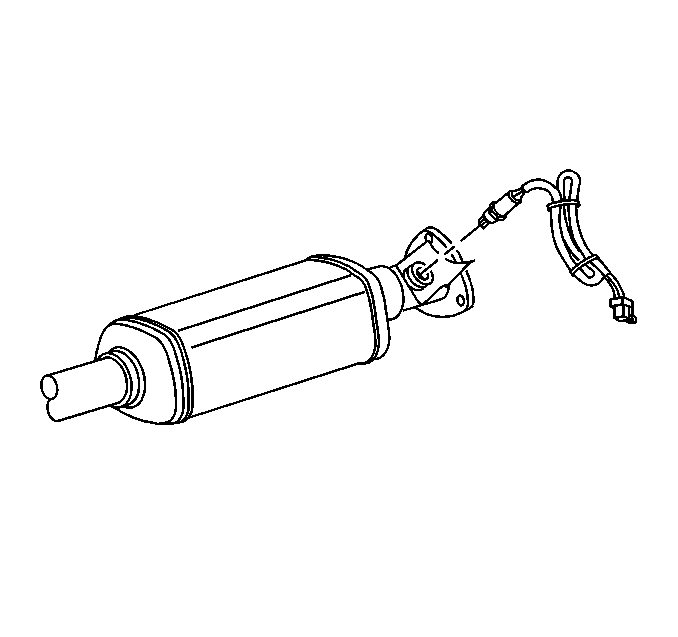
Circuit Description
To control emissions of Hydrocarbons (HC), Carbon Monoxide (CO), and Oxides of Nitrogen (NOx), a three-way catalytic converter is used. The catalyst within the converter promotes a chemical reaction which oxidizes the HC and CO present in the exhaust gas, converting them into harmless water vapor and carbon dioxide. The catalyst also reduces NOx, converting it to nitrogen. The PCM has the ability to monitor this process using the HO2S 1 and the HO2S 2 heated oxygen sensors. The HO2S 1 sensor produces an output signal which indicates the amount of oxygen present in the exhaust gas entering the three-way catalytic converter. The HO2S 2 sensor produces an output signal which indicates the oxygen storage capacity of the catalyst, this in turn indicates the catalysts ability to convert exhaust gases efficiently. If the catalyst is operating efficiently, the HO2S 1 signal will be far more active than that produced by the HO2S 2 sensor. If the PCM detects a level of HO2S 2 activity that indicates the catalyst is no longer operating efficiently, DTC P0420 will be set.
The PCM determines if the catalyst is ready for testing based on the following criteria:
| • | Intake air temperature is above -18°C (0°F). |
| • | Engine Coolant Temperature is above 75°C (167°F). |
| • | Mass Air Flow is greater than 7 gm/s. |
| • | Engine load is below 63% and steady. |
| • | Engine speed is less than 4000 RPM. |
| • | Above conditions met for about 4 minutes. |
This ensures that the catalyst is sufficiently warmed up for testing purposes. Once these conditions have been met, the PCM can begin collecting the catalyst diagnostic test samples.
Conditions for Setting the DTC
| • | No MAF sensor, TP sensor, IC, EGR, injector circuit, misfire, MAP sensor, EVAP, CKP sensor, HO2S, ECT sensor, Fuel trim, IAT sensor or VSS DTC(s) set. |
| • | Catalyst is ready for testing (refer to Circuit Description). |
| • | Engine speed is between 600 and 4000 RPM. |
| • | Vehicle speed between 20 and 121 kph. |
| • | The PCM determines that the catalysts oxygen storage capacity is below a threshold considered acceptable. |
Action Taken When the DTC Sets
| • | The PCM will illuminate the malfunction indicator lamp (MIL) during the second consecutive trip in which the diagnostic test has been run and failed. |
| • | The PCM will store conditions which were present when the DTC set as Freeze Frame and Failure Records data. |
Conditions for Clearing the MIL/DTC
| • | The PCM will turn OFF the MIL during the third consecutive trip in which the diagnostic has been run and passed. |
| • | The History DTC will clear after 40 consecutive warm-up cycles have occurred without a malfunction. |
| • | The DTC can be cleared by using the scan tool. |
Diagnostic Aids
Check for the following conditions:
| • | Poor connection at PCM. Inspect harness connectors for backed out terminals, improper mating, broken locks, improperly formed or damaged terminals, and poor terminal to wire connection. |
| • | Damaged harness. Inspect the wiring harness for damage. If the harness appears to be OK, observe the display on the scan tool while moving connectors and wiring harnesses related to the sensor. A change in the display will indicate the location of the fault. |
Reviewing the Fail Records vehicle mileage since the diagnostic test last failed may help determine how often the condition that caused the DTC to be set occurs. This may assist in diagnosing the condition.
| • | HO2S 1/HO2S 2 Activity Test: |
| - | Using a scan tool, monitor HO2S 1 and HO2S 2 displays in Park while using the scan tool IAC RPM control function to maintain a mass air flow of 10 gm/s. Compare the amount of activity (frequency and amplitude) on HO2S 1 to the activity on HO2S 2 over a 30 second period. |
| - | If the amount of activity on HO2S 2 is nearly as great as the activity on HO2S 1, a problem exists use the DTC P0420 diagnostic chart. If much less activity is noted on HO2S 2, the system is functioning properly. |
The TWC Monitor Test Counter displayed on the scan tool may be used to monitor the progress of the TWC diagnostic. To complete the TWC diagnostic with a good catalyst, the counter must be allowed to increment to 49 samples and roll over to 0 at least once. A failed catalyst may require three or more 50 sample tests to report a failure.
Test Description
Number(s) below refer to the step number(s) on the Diagnostic Table:
Step | Action | Value(s) | Yes | No | ||||||||
|---|---|---|---|---|---|---|---|---|---|---|---|---|
1 | Was the Powertrain On Board Diagnostic (OBD) System Check performed? | -- | ||||||||||
2 | Are any other DTC(s) set? | -- | Go to the Applicable DTC Table Refer to Powertrain Control Module Diagnosis | |||||||||
3 |
Did your inspection reveal a problem? | -- | ||||||||||
4 |
Did your inspection reveal a problem? | -- | ||||||||||
5 |
Did your inspection reveal a problem? | -- | ||||||||||
6 | Replace the three-way catalytic converter. Refer to Exhaust System. Notice: A misfiring condition may damage the replacement three-way catalytic converter. Check for a misfiring condition. If a misfire is present, repair the misfiring condition before replacing the three-way catalytic converter. Is the action complete? | -- | -- | |||||||||
Note the test result, does scan tool indicate DTC P0420 Test Ran and Passed? | 75°C (167°F) 12-15 gm/s | System OK |
